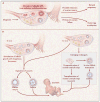Preservation of fertility in patients with cancer
- PMID: 19246362
- PMCID: PMC2927217
- DOI: 10.1056/NEJMra0801454
Preservation of fertility in patients with cancer
Conflict of interest statement
No potential conflict of interest relevant to this article was reported.
Figures



Comment in
-
Preservation of fertility in patients with cancer.N Engl J Med. 2009 Jun 18;360(25):2680; author reply 2682-3. doi: 10.1056/NEJMc090614. N Engl J Med. 2009. PMID: 19535811 No abstract available.
-
Preservation of fertility in patients with cancer.N Engl J Med. 2009 Jun 18;360(25):2680-1; author reply 2682-3. N Engl J Med. 2009. PMID: 19537322 No abstract available.
-
Preservation of fertility in patients with cancer.N Engl J Med. 2009 Jun 18;360(25):2681-2; author reply 2682-3. N Engl J Med. 2009. PMID: 19537323 No abstract available.
-
Preservation of fertility in patients with cancer.N Engl J Med. 2009 Jun 18;360(25):2681; author reply 2682-3. N Engl J Med. 2009. PMID: 19537324 No abstract available.
-
Preservation of fertility in patients with cancer.N Engl J Med. 2009 Jun 18;360(25):2682; author reply 2682-3. N Engl J Med. 2009. PMID: 19537325 No abstract available.
References
-
- Woodruff TK. The emergence of a new interdiscipline: oncofertility. Cancer Treat Res. 2007;138:3–11. - PubMed
-
- Agarwal SK, Chang RJ. Fertility management for women with cancer. Cancer Treat Res. 2007;138:15–27. - PubMed
-
- Donaldson SS, Link MP, Weinstein HJ, et al. Final results of a prospective clinical trial with VAMP and low-dose involved-field radiation for children with low-risk Hodgkin's disease. J Clin Oncol. 2007;25:332–7. - PubMed
-
- Hayes DF, Thor AD, Dressler LG, et al. HER2 and response to paclitaxel in nodepositive breast cancer. N Engl J Med. 2007;357:1496–506. - PubMed
Publication types
MeSH terms
Grants and funding
LinkOut - more resources
Full Text Sources
Other Literature Sources
Medical
